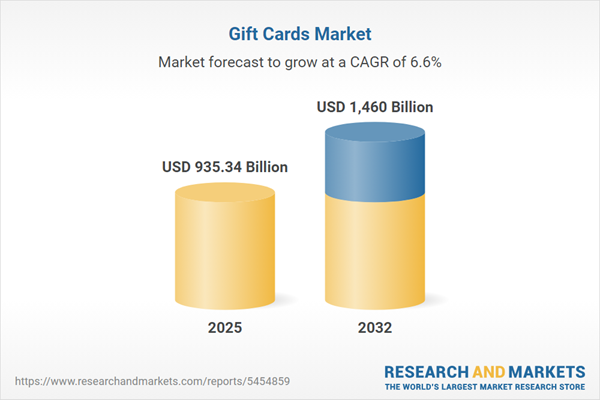Speak directly to the analyst to clarify any post sales queries you may have.
The global gift cards market is rapidly evolving in response to accelerating digital transformation, shifting consumer behaviors, and expanding merchant ecosystems. Senior decision-makers are seeking actionable insights to navigate this dynamic landscape, optimize customer loyalty strategies, and enhance operational resilience.
Market Snapshot: Gift Cards Market Size & Growth Potential
The Gift Cards Market grew from USD 879.43 billion in 2024 to USD 935.34 billion in 2025. It is expected to continue growing at a CAGR of 6.59%, reaching USD 1.46 trillion by 2032. This robust trajectory highlights strong demand across both consumer and corporate channels, accelerated by widespread adoption of mobile wallets and digital gift solutions. Expansion is being fueled by innovation in digital experiences and the rising role of data-driven personalization in customer engagements.
Scope & Segmentation of the Gift Cards Market
This report delivers a granular analysis of the global gift card ecosystem, with targeted insights across products, channels, applications, and end users. Key segments include:
- Card Types: Digital gift certificates; Physical cards
- Issuer Types: Closed loop for specific merchants; Open loop via payment networks
- End Users: Consumer (peer-to-peer, personal recipients); Corporate (B2B gifting, employee incentives)
- Distribution Channels: Offline (convenience stores, drug stores, grocery, mass merchandisers, specialty retailers); Online (direct sellers, e-retailers, mobile apps)
- Applications: Gifting; Incentives (referral, sales performance); Loyalty rewards (coalition programs, points-based, tier-based memberships)
- Industry Verticals: Entertainment, gaming, restaurants, retail, travel
- Regions: Americas (United States, Canada, Mexico, Brazil, Argentina, Chile, Colombia, Peru); Europe, Middle East & Africa (United Kingdom, Germany, France, Russia, Italy, Spain, Netherlands, Sweden, Poland, Switzerland, UAE, Saudi Arabia, Qatar, Turkey, Israel, South Africa, Nigeria, Egypt, Kenya); Asia-Pacific (China, India, Japan, Australia, South Korea, Indonesia, Thailand, Malaysia, Singapore, Taiwan)
The analysis also covers major vendors shaping the market, such as Amazon.com, Apple, Starbucks, Target, The Home Depot, Best Buy, InComm Payments, Blackhawk Network, Visa, and Edenred.
Key Takeaways for Senior Decision-Makers
- Digital innovation and mobile-first strategies are redefining gift card delivery, driving demand for seamless integrations and instant fulfillment.
- Corporate applications, particularly for B2B gifting and employee rewards, are expanding, prompting tailored solutions for businesses and organizations.
- Emerging technologies—including tokenization and blockchain—are being piloted to improve traceability, security, and consumer trust across digital and physical cards.
- Market leaders are leveraging data analytics to capture granular insights on redemption and usage, optimizing promotions and loyalty schemes.
- Collaboration among payment networks, aggregators, and retailers is enabling robust omnichannel and coalition loyalty platforms, broadening customer reach.
United States Tariff Impact: Supply Chain and Strategic Response
Recent implementation of U.S. trade tariffs has exerted pressure on gift card supply chains, particularly affecting physical card producers through elevated import duties on substrates and security elements. Stakeholders are responding by shifting production, renegotiating global contracts, and accelerating transitions to digital voucher platforms. Enhanced scrutiny by customs authorities is also prompting investments in compliance teams and advanced digital documentation systems, further reinforcing the trend toward digital and regionally localized approaches.
Methodology & Data Sources
This research employs a combined methodology built on primary interviews with executives from issuing banks, retailers, gift card aggregators, and technology providers. Rigorous secondary research includes industry publications, regulatory documents, and corporate disclosures. Quantitative analysis utilizes regression modeling and scenario planning, with expert panels providing additional validation of findings and recommendations.
Why This Report Matters for Executives
- Access prioritized insights for shaping resilient, data-driven gift card strategies in increasingly complex regulatory and digital landscapes.
- Understand how to leverage leading-edge technology platforms and API integrations to build agile, customer-centric value propositions.
- Identify regional and application-based growth opportunities to maximize corporate rewards, customer retention, and cross-border potential.
Conclusion
As digitalization and regulatory shifts accelerate, stakeholders must align strategies with emerging technologies and evolving regional differences. This report equips senior leaders with essential intelligence to inform investment, foster innovation, and capture growth in the fast-changing global gift cards market.
Additional Product Information:
- Purchase of this report includes 1 year online access with quarterly updates.
- This report can be updated on request. Please contact our Customer Experience team using the Ask a Question widget on our website.
Table of Contents
3. Executive Summary
4. Market Overview
7. Cumulative Impact of Artificial Intelligence 2025
Companies Mentioned
The companies profiled in this Gift Cards market report include:- Amazon.com, Inc.
- Apple Inc.
- Starbucks Corporation
- Target Corporation
- The Home Depot, Inc.
- Best Buy Co., Inc.
- InComm Payments, Inc.
- Blackhawk Network, Inc.
- Visa Inc.
- Edenred Sp. z o.o.
Table Information
| Report Attribute | Details |
|---|---|
| No. of Pages | 186 |
| Published | November 2025 |
| Forecast Period | 2025 - 2032 |
| Estimated Market Value ( USD | $ 935.34 Billion |
| Forecasted Market Value ( USD | $ 1460 Billion |
| Compound Annual Growth Rate | 6.5% |
| Regions Covered | Global |
| No. of Companies Mentioned | 11 |









